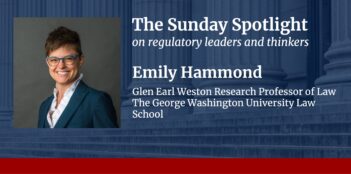
Data show that geography and party affiliation predict state agencies’ pushback against federal policies.
The vertical fragmentation of regulatory authority in the U.S. political system creates numerous opportunities for conflict between federal and state governments. In the context of energy policy, one such opportunity arises from the dual authority of the states and federal government to regulate electricity markets and infrastructure. This dual authority over utility policy allows state regulators with preferences different from their federal counterparts to resist national utility policy. Under what conditions do states resist these federal regulatory efforts?
The Federal Energy Regulatory Commission (FERC) and various state-level energy regulators have recently debated the respective responsibilities of the federal and state governments in the energy regulation context. Some state regulators argue that authority over utility regulation ought to be decentralized, reserving as much power to the states as possible. But FERC has maintained that barriers to interstate cooperation ought to be lifted, stripping some power from those state agencies that cannot regulate commerce outside their geographical borders.
These arguments concerning centralization play out frequently in American politics. In the context of energy policy, the regulatory scheme engendered by the Federal Power Act of 1920 serves as the venue for such arguments. The Federal Power Act authorized the federal government to regulate “the transmission of electric energy in interstate commerce and…the sale of electric energy at wholesale in interstate commerce,” while implicitly reserving all remaining aspects of service and delivery to the states through the Tenth Amendment.
This scheme of dual federalism, where federal and state authority do not overlap, was appropriately tailored to the United States in the 1920s. But as energy markets have evolved, the clear divide between state and federal authority has blurred. Energy markets have become increasingly interstate in nature. In addition, FERC has affirmatively expanded its own jurisdiction by encouraging firms to engage in interstate commerce through Order No. 1000, a rule that set requirements for public utility transmission planning and cost allocation.
In response to FERC’s Order, public utility commissions in Alabama, Illinois, and South Carolina sued FERC, objecting to the Order as an impermissible extension of federal authority. Although all three commissions eventually lost in federal court, these agencies strongly signaled their objection to FERC policy.
This federalist contretemps should come as no surprise to careful observers of regulatory politics. We know that state agencies often attempt to resist federal policy either through discourse, such as press releases or conference statements, or through action, such as litigation or rulemaking.
We do not know, however, the conditions under which state agencies will resist a federal agency. We lack a general theory of state bureaucratic behavior with respect to federal policy.
Observers and journalists often argue that jurisdictional chauvinism motivates resistance. States attempt to secure as much power as they can—full stop. Similarly, some observers assert that agencies led by Republicans resist federal policy more often because Republican principles object to centralization.
However, new research we conducted on the determinants of state bureaucratic resistance to federal administrative policy demonstrates that, rather than jurisdictional parochialism or a philosophical commitment to federalism, partisanship drives resistance. Simply put, state agencies—whether led by Republicans or Democrats—resist their federal counterparts more often when opposing parties control the state and federal agencies.
To test empirically what drives bureaucratic resistance, we collected data on state utility regulators’ decisions to initiate or join resistance litigation against FERC across all 50 states over an eight-year period, from 2010 to 2017. We found that the decision to resist via litigation rarely occurred, as only 5.5 percent of state utility regulators resisted across our sample of eight years. But we also found that two factors disproportionately affect an agency’s decision to resist: conflicting partisanship within FERC itself, and whether the agency is from a state in the U.S. South.
To test this proposition, we were faced with the task of collecting information on all public utility regulators at the state and federal levels from 2010 to 2017. This task was made much simpler due to the work of Janice Beecher, who has collected the names and parties of all state utility regulators from the 19th century to today.
Using multivariate logistic regression—a statistical method that estimates the probability of some action or outcome while holding key variables constant—we found that, although a state utility regulator controlled by the same party as FERC has about a 1.7 percent chance of resisting FERC decisions, a state regulator whose partisanship conflicts with that of FERC has about a 6.6 percent chance of resisting. Additionally, state utility agencies from non-Southern states have only about a 2.6 percent chance of resisting, while those from Southern states have about a 10.8 percent chance of resisting FERC.
These probabilities control for various political, demographic, and administrative factors that may impact state bureaucratic resistance, including the underlying partisanship of the state, whether the state agency has elected leaders, the partisan composition of the state legislature, the percentage of commissioners on the state agency that are Republican, and the percentage of the population that lives in rural areas.
These results suggest that a state agency’s decision to resist federal administrative policy through litigation is not driven by anti-centralization ideology, legislative or public pressure on the agency to resist, or the underlying economy of the state. Rather, it is driven by partisanship—namely, the partisanship of pivotal leaders in state agencies.
Our findings have important implications for understanding regulatory politics. These results call into question the idea that bureaucratic agencies operate as technocratic, politically neutral institutions. They argue against top-down theories of bureaucracy that posit that bureaucratic institutions act only as the legislature or chief executive prefers. And they suggest that polarization in the United States extends even to the heads of the bureaucracy.
This essay draws on the authors’ recent article, entitled Their Boot in Our Face No Longer? Administrative Sectionalism and Resistance to Federal Authority in the U.S. South.





